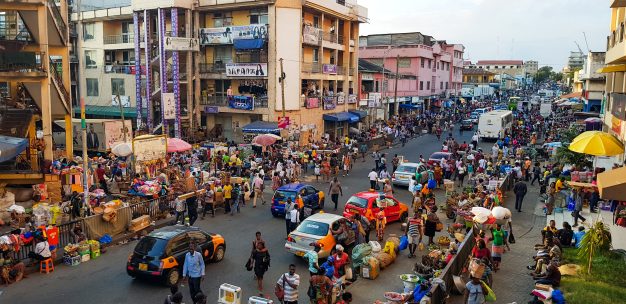
‘Clean air’ project in Accra aims to protect the health of youngsters
Accra, Ghana’s capital, is the latest major city to host a comprehensive ‘clean air’ project headed by the Global Designing Cities Initiative (GDCI) that focuses chiefly on the health implications for children and young people.
Support comes from the Clean Air Fund, a global philanthropic organisation that works closely with with governments, the business community and health campaigners to try and create a future where everyone is able to breathe clean air.
The year-long Removing Pollution from Play project is running until October this year, and sees the GDCI working with Accra’s Korle Klottey Municipality to highlight how ‘reimagined’ streets can promote cleaner air. A temporary street transformation project is underway that will showcase what is a vital connection.
Accra is the fastest growing city in Africa, a continent where, says GDCI, some 65 per cent of the population is predicted to live in cities by 2060. As the commercial hub of Ghana, it adds, there are an estimated 2.5 million commuters for work and business, which means road transport contributes a significant 40 per cent of Accra’s PM2.5 air pollution concentrations. Figures from the World Health Organization (WHO) show that more than 28,000 Ghanaians, many of them children, die prematurely every year as a result of air pollution.
‘Mounting pressure to achieve climate change’
“Access to a healthy environment was declared a basic human right in 2022 by the UN General Assembly, but advancing economic growth while transitioning to cleaner forms of transport and energy for both industrial and residential use, is challenging,” says the GDCI.
“Worldwide, but particularly in the global south, there is mounting pressure to achieve ambitious climate change goals and drastically reduce greenhouse gas emissions (GHGs). This is despite the fact that the African continent produces less than three per cent of the world’s GHG emissions.”
WHO’s air quality guidelines outline which airborne pollutants are considered most harmful healthwise. These include ozone, oxides of nitrogen, sulfur dioxide, and carbon monoxide, as well as fine particulate matter. Fine particulate matter (PM 2.5) is the key indicator used in making health estimates of air pollution impacts and is most commonly measured or monitored by governments around the world to protect citizens against the adverse impacts of air pollutants.”
These kinds of particulate matter are tiny – approximately 2.5 micrometers – compared to the average human hair, which measures around 70 micrometers in diameter. That means they are more easily inhalable and could even enter the bloodstream.
GDCI says its project will focus on children and youth, as they are considered the most vulnerable groups in terms of exposure to air pollution and its impacts
More than 90 per cent of children under the age of 15 years are severely inhibiting their development and negatively impacting their health by breathing polluted air daily.
Children’s charity UNICEF says the early years of a child’s life are ‘critical for cognitive, social, emotional and physical development’. This means tackling poor air quality needs to be done today to prevent future generations from suffering chronic respiratory diseases or developmental issues.
‘See if we can create a safe place’
This new ‘transforming streets’ project will, adds GDCI, explore the various ways in which innovations and fresh thinking in urban design can help to reduce air pollution.
Hayrettin Günc, Program Manager, says: “We will start with a pilot project, select one school, and see if we can create a safe space for kids to play, removed from air pollution, and then showing the results so we can implement these kinds of projects in different areas of the municipality.”
Accra has also endorsed the GDCI’s multi-lingual Global Street Design Guide, showing their commitment to transforming streets, public spaces, and cities for people.
Click here for more on the project.




